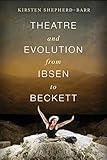Theatre and Evolution from Ibsen to Beckett / Kirsten Shepherd-Barr.
Material type: TextPublisher: New York, NY : Columbia University Press, [2015]Copyright date: ©2015Description: 1 online resource (400 p.) : ‹B›6 b&w illustrations‹/B›Content type:
TextPublisher: New York, NY : Columbia University Press, [2015]Copyright date: ©2015Description: 1 online resource (400 p.) : ‹B›6 b&w illustrations‹/B›Content type: - 9780231164702
- 9780231538923
- 700.1/05 23
- online - DeGruyter
- Issued also in print.
| Item type | Current library | Call number | URL | Status | Notes | Barcode | |
|---|---|---|---|---|---|---|---|
 eBook
eBook
|
Biblioteca "Angelicum" Pont. Univ. S.Tommaso d'Aquino Nuvola online | online - DeGruyter (Browse shelf(Opens below)) | Online access | Not for loan (Accesso limitato) | Accesso per gli utenti autorizzati / Access for authorized users | (dgr)9780231538923 |
Browsing Biblioteca "Angelicum" Pont. Univ. S.Tommaso d'Aquino shelves, Shelving location: Nuvola online Close shelf browser (Hides shelf browser)

|

|

|

|

|

|

|
||
| online - DeGruyter The Highway of Despair : Critical Theory After Hegel / | online - DeGruyter Motion(less) Pictures : The Cinema of Stasis / | online - DeGruyter Global Alert : The Rationality of Modern Islamist Terrorism and the Challenge to the Liberal Democratic World / | online - DeGruyter Theatre and Evolution from Ibsen to Beckett / | online - DeGruyter Marching Through Suffering : Loss and Survival in North Korea / | online - DeGruyter Christo-Fiction : The Ruins of Athens and Jerusalem. | online - DeGruyter Nietzsche Versus Paul / |
Frontmatter -- Contents -- Preface -- Acknowledgments -- Introduction -- 1. "I'm Evolving!": Birds, Beasts, and Parodies -- 2. Confronting the Serious Side -- 3. "On the Contrary!": Ibsen's Evolutionary Vision -- 4. "Ugly . . . but Irresistible": Maternal Instinct on Stage -- 5. Edwardians and Eugenicists -- 6. Reproductive Issues -- 7. Midcentury American Engagements with Evolution -- 8. Beckett's "Old Muckball" -- Epilogue: Staging the Anthropocene -- Notes -- Index
restricted access online access with authorization star
http://purl.org/coar/access_right/c_16ec
Evolutionary theory made its stage debut as early as the 1840s, reflecting a scientific advancement that was fast changing the world. Tracing this development in dozens of mainstream European and American plays, as well as in circus, vaudeville, pantomime, and "missing link" performances, Theatre and Evolution from Ibsen to Beckett reveals the deep, transformative entanglement among science, art, and culture in modern times.The stage proved to be no mere handmaiden to evolutionary science, though, often resisting and altering the ideas at its core. Many dramatists cast suspicion on the arguments of evolutionary theory and rejected its claims, even as they entertained its thrilling possibilities. Engaging directly with the relation of science and culture, this book considers the influence of not only Darwin but also Lamarck, Chambers, Spencer, Wallace, Haeckel, de Vries, and other evolutionists on 150 years of theater. It shares significant new insights into the work of Ibsen, Shaw, Wilder, and Beckett, and writes female playwrights, such as Susan Glaspell and Elizabeth Baker, into the theatrical record, unpacking their dramatic explorations of biological determinism, gender essentialism, the maternal instinct, and the "cult of motherhood."It is likely that more people encountered evolution at the theater than through any other art form in the late nineteenth and early twentieth centuries. Considering the liveliness and immediacy of the theater and its reliance on a diverse community of spectators and the power that entails, this book is a key text for grasping the extent of the public's adaptation to the new theory and the legacy of its representation on the perceived legitimacy (or illegitimacy) of scientific work.
Issued also in print.
Mode of access: Internet via World Wide Web.
In English.
Description based on online resource; title from PDF title page (publisher's Web site, viewed 02. Mrz 2022)


